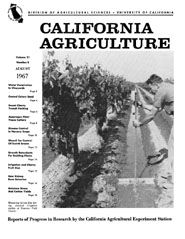


University of California
California Agriculture
|
|||
|
|||

Measuring furrow flow during vineyard irrigation studies at Kearney Field Station.
August 1967
Volume 21, Number 8 General Information |
|||
|
University of California, 1301 S. 46th St., Bldg. 478 Richmond, CA
|